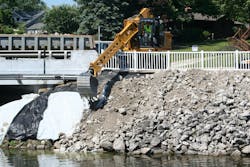Coventry Township, Ohio, finds effective way to handle its shoreline
Coventry Township, located not far from Akron, Ohio, includes the Portage Lakes area—a system of reservoirs connected by a series of channels that were created in the mid-1800s to maintain water depth in shipping canals. Today, Portage Lakes is a resort area, with some 4,000 upscale homes dotting the shoreline.
The road department in Coventry Township is responsible for maintaining over 54 miles of roads around the lakes, along with maintaining an extensive network of roadside drainage ditches and other work.
Along the banks of the lakes, the department constantly upgrades the shoreline to control vegetation, restore damage from erosion and for general beautification—jobs that the township said continually challenge the versatility of its excavator.
The township’s XL 3300 III Gradall excavator was recently assigned to work on a 300-ft section of shoreline in the East Reservoir, near a water-skiing zone and at the edge of an important Portage Lakes commercial area.
The task was to clear away weeds and debris from the shoreline and then spread about 250 tons of rip-rap to repel erosion damage from ski-boat wake. It’s a job that could not be handled efficiently either with manpower or any other single machine, according to Lael Stouffer, superintendent of the township’s road department.
The excavator, with an on-off pavement wheeled undercarriage, was positioned along the edge of the road to work over a fence, using the full 27 ft of boom reach. During grading and cleanup, the 220-degree full boom tilt allowed the bucket to mimic the natural curves of the shoreline. The boom tilt function also precisely placed the rip-rap, using the “bucket shake” feature to evenly spread smaller stones and gravel.
With a compact counterweight design, the carrier blocked only one lane of traffic, which was important on the two-lane road. The low profile of the working boom was able to reach under occasional overhead obstacles and, because the entire boom tilts rather than relying on a boom-end bucket rotation attachment, the machine had enough full-reach power to move the heavy rocks.
